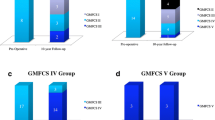Abstract
This study used the Pediatric Evaluation of Disability Inventory as a functional assessment tool for children with spastic cerebral palsy undergoing selective posterior rhizotomy. Sixteen patients were followed for 3–12 months following surgery. Improvement in self-care, mobility, and social functional skills were found. Overall, the patients required less caregiver assistance and needed fewer modifications for self-care. The results suggest that selective posterior rhizotomy improves the quality of life in children with spastic cerebral palsy.
Similar content being viewed by others
References
Arens LJ, Peacock WJ, Peter J (1989) Selective posterior rhizotomy. A long term follow-up study. Child's Nerv Syst 5:148–152
Berman B, Vaughan CL, Peacock WJ (1990) The effect of rhizotomy on movement in patients with cerebral palsy. Am J Occup Ther 44:511–516
Cahan LD, Adams J, Perry J, Beeler L (1990) Instrumented gait analysis after selective dorsal rhizotomy. Dev Med Child Neurol 32:1037–1043
Fasano VA, Broggi G, Barolat-Romana G, Squazzi A (1978) Surgical treatment of spasticity in cerebral palsy. Child's Brain 43:289–305
Feldman AB, Haley SM, Coryell J (1990) Concurrent and construct validity of the pediatric evaluation of disability inventory. Phys Ther 70: 602–610
Oppenheim WL (1990) Selective posterior rhizotomy for spastic cerebral palsy: a review. Clin Orthop 253:20–29
Peacock WJ, Arens LJ, Berman B (1987) Cerebral palsy spasticity: selective posterior rhizotomy. Pediatr Neurosci 13:61–66
Vaughan CL, Berman B, Staudt LA, Peacock WJ (1989) Gait analysis of cerebral palsy children before and after rhizotomy. Pediatr Neurosci 14:297–300
Vaughan CL, Berman B, Peacock WJ (1991) Cerebral palsy and rhizotomy: a 3-year follow-up evaluation with gait analysis. J Neurosurg 74:178–184
Author information
Authors and Affiliations
Rights and permissions
About this article
Cite this article
Bloom, K.K., Nazar, G.B. Functional assessment following selective posterior rhizotomy in spastic cerebral palsy. Child's Nerv Syst 10, 84–86 (1994). https://doi.org/10.1007/BF00302767
Received:
Revised:
Issue Date:
DOI: https://doi.org/10.1007/BF00302767




